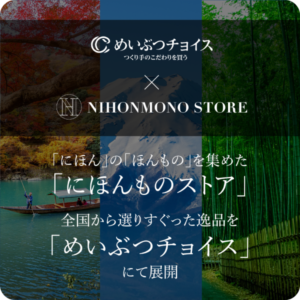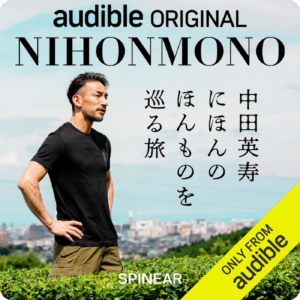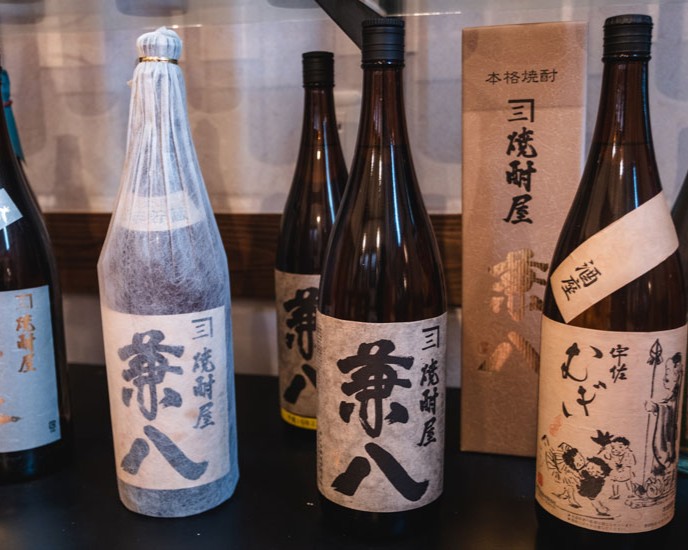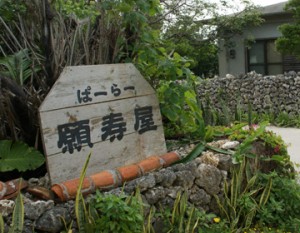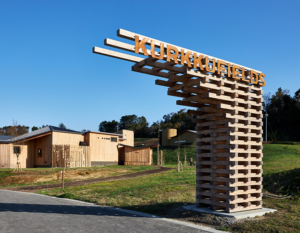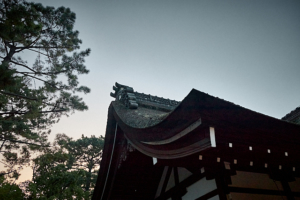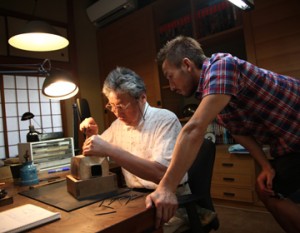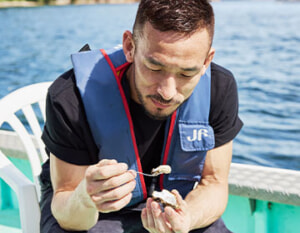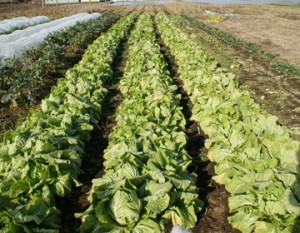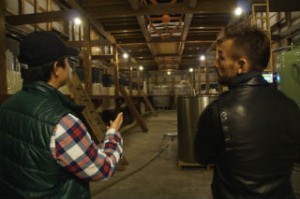Usa City in Oita Prefecture is famous for Usa Jingu Shrine, the head temple of Hachimangu Shrine. Yotsuya Shuzo, a sake brewery, is located in a good old fishing town surrounded by a rich natural environment of mountains, basins, and plains. How was “Kanehachi,” one of the most difficult shochu to obtain in Japan, born? We visited Mr. Takaaki Yotsuya, the fifth generation of the brewery, to learn about the roots of the shochu and his passion for it.
Translated with DeepL.com (free version)
History of Yotsuya Brewery

Yotsuya Brewery was founded in 1919. The founder “Yotsuya Kanehachi,” who was originally a fish market merchant, could not forget the taste of shochu he drank while running several private fish markets and touring various prefectures in Kyushu, and obtained a license for shochu as a side business. Today, Mr. Takeaki Yotsuya, the fifth generation to inherit the sake brewery, which has been in operation for over 100 years. His grandfather, the third generation, was killed in the war, and his father, the fourth generation, joined the brewery as soon as he graduated from high school.
From an aspiring businessman to a warehouseman

Takeaki grew up as the son of a sake brewer, but at the time he had no interest in the family business and went to university in the mathematics department of the Faculty of Science. He recalls that in the fishing town where he was born and raised, he had a yearning to be a businessman, something he rarely saw in his hometown. When he graduated, the world was at the height of the bubble economy. He started his life as a smooth sailing businessman as a system engineer at Matsushita Electric (now Panasonic). A few years later, he was put in charge of overseas operations and spent his days traveling back and forth between Singapore and Malaysia. He originally enjoyed drinking alcohol, but instead of the Japanese sake he was used to drinking, he became addicted to Western liquors such as bourbon, scotch, and wine, and enjoyed drinking alcoholic beverages from many different countries.
The turning point was “Iichiko
It was a smooth life as a salaried worker, but he was not finding satisfaction in his work. I found Iichiko, a barley shochu made by Sanwa Shushuizu, a sake brewer in my hometown of Usa, where I was born and raised, in the liquor section of a small Wal-Mart in front of the hotel where I was staying overseas.” I had a selfish thought in my mind that 30 was a turning point in my life, and the sight of Iichiko reminded me of my family’s shochu brewery. I thought to myself, “This is it, let’s go home! Mr. Takeaki says he had a sense of inspiration. That was the moment he decided to return home.
Homecoming and harsh reality

Although he returned home, Yotsuya Sake Brewery was barely keeping up with business. The number of employees and the number of stones produced were minimal. He recalls that he was concerned about whether he would be able to make it as a novice sake brewer, but he was more anxious to learn how to make sake first. His father, who had learned on the job rather than in theory, was the type who told him to learn his work on the job without any specific guidance. On the other hand, Takeaki, who was a system engineer with a science background, was a theoretical person who learned everything by logic. It was difficult for him to understand the “craftsman’s sense,” so he had to learn by himself from scratch. Although he did not know what was right and what was left every day, Takeaki showed the true nature of what he had learned from his science background. With a stopwatch in hand, he calculated the numerical values of all the processes involved in sake brewing, taking averages as he went along. He learned the basics of sake brewing from a book titled “Authentic Shochu Manufacturing Technology.”
“I want to make sake that I think tastes good.”

At that time, they were following the major manufacturers in the industry in terms of taste and pricing, so prices were uniform. There was also a tendency to sell only the lighter-mouthed types made with the same reduced-pressure distillation as the major players. In addition, the domestic self-sufficiency rate for barley, the raw material for shochu, was only a few percent, and more than 90 percent was imported. It was only 2-row barley, and “Usa Mugi,” Yotsuya Shuzo’s main product at the time, also used 2-row barley. Although sales were stable to a certain extent, about a year after returning home, Takeaki began to think about the flavor he wanted, saying, “I want to make sake that I like, not what we have now.
What made him realize this was the time he spent with his father over sake after work. As they discussed not only sake brewing, but also various other things, he decided to make not the easy-to-drink shochu that was the mainstream at the time, but a savory, deep-flavored shochu that he liked. His father’s message to him was, “It’s fine to make shochu, but you have to take responsibility for what you make,” and he began making it on a trial basis, which was the beginning of the shochu that would become Kakehachi.
Determination to use local barley to arrive at “Kanehachi”

That is how he started brewing sake in 2000. In his search for the flavor he wanted, Takeaki turned his attention to hadakamugi, or six-row barley, which had been planted in some rice paddies in the Usa Plain as part of a policy of reducing the amount of land devoted to rice cultivation. This barley, which is rare and rich in nutrients among barleys, is an ancient Japanese variety, and the company wanted to support local farmers by using this barley anyway. We decided to use locally grown Rokujo barley because we wanted to tell people that this barley makes a delicious shochu. Compared to 2-row barley, 6-row barley has smaller grains and lower starch content. This means that less saccharification takes place, and less alcohol is obtained. Therefore, it has been frowned upon in sake brewing, but in order to pursue the strong aroma that Takeaki wanted to produce, he began using it on a trial basis.
Because of his desire to value each grain of barley and his insistence on flavor, he also built an atmospheric distillation machine to his original specifications. After about two years of repeated trial and error, the sake was completed with a unique flavor that had never been tasted before. Takeaki says, “I would be lying if I said I wasn’t anxious. He gave up on the idea that he had no taste for sake brewing if this did not sell well, and out of his determination to change jobs, he named the sake Kanehachi, after Yotsuya Kanehachi, the founder of the Yotsuya Sake Brewery. This determination was the proof that he was not influenced by the trends of the times, and that he was committed to “making shochu that is not in the mainstream.
Newspaper article that led to the name “Phantom Shochu”

In 2002, Yotsuya Shuzo experienced a major turning point. Even though “Usa Mugi” was still selling better at the time, Kenpachi was ranked 10th in the “Shochu Recommended by Experts” section of the Nikkei newspaper. This was a bolt out of the blue for Takeaki, who knew nothing about it. Some of the respondents were not happy with the taste, saying that it tasted different from regular shochu, but those who preferred the taste greatly outweighed those who did not, and it became the talk of the town. This led to a jump in popularity for Kenpachi, and orders began pouring in from all over the country. Some drinkers think that “savory” means “burnt smell,” so most breweries tend to suppress this peculiarity, but Takeaki is different. I wanted to go all out with the savory flavor. I just prefer it this way. The result of his pursuit of this belief-like persistence has been well-received by the world, and the popularity of Kanehachi has been unwavering.
Development of “Toyonohoshi” barley for shochu

Even after “Kanehachi” became a hit, Takeaki’s challenges did not end there. As the chairman of the production technology committee of the Oita Prefecture Sake Brewers Association, Takeaki was also involved in the development of barley for use in shochu. In the past, imported 2-row barley was commonly known as “beer barley.” Because it was used under the leadership of beer brewers, there was an image in the industry that shochu was made from the same barley used in beer, and he felt frustrated by this. With this in mind, he launched a project with local breweries, and the result was a new variety of barley called Toyonohoshi. The city of Usa, rich in nature, has a mild climate with little rainfall, making it an ideal place to grow barley. Grown from scratch in Usa, TOYONOHOSHI is highly nutritious due to the soil, and has a sweeter and richer flavor than ordinary 2-row barley. Sake made with TOYONOHOSHI, which took about 10 years to develop, is branded with the name TOYONOHOSHI in the product name, regardless of which brewery it is made from. Naturally, Kenpachi also has a “Kanehachi Toyonohoshi” made with Toyonohoshi, and the yeast used is Oita Prefecture’s proprietary yeast for shochu, Oita Yeast, extracted from Oita Prefecture’s famous “kabosu” . It has a barley aroma with a tart kabosu flavor that lingers on the palate.
Yotsuya Shuzo, which aims to create “innovative and traditional shochu,” is not content to rest on its laurels with hit products, and is constantly developing new products. Takeaki smiles as he explains that the only thing keeping him going is his desire to “pursue the art of making shochu.
Sake, the pride of Japan and Oita, to the world

The word “SAKE” now means Japanese sake in foreign countries, and with the global boom in Japanese food, sake exports are also increasing. Shochu, however, is still on the decline. Shochu is a distilled liquor, and there is no custom overseas to drink distilled liquor as a food alcohol. The challenge for the future, says Takeaki, is how to convey the concept to Europe and the United States. When I was living in Singapore and told my friends that I was going back to Japan to make shochu, they didn’t understand the word “shochu.”
He also hopes to plant seeds that will make it easier for the next generation to express themselves in the future. By researching raw materials, barrels, and yeast, Takeaki hopes to create an environment where young juniors can be creative.
“I don’t need to be the final expression.”
With the confidence and accomplishments of the man who created Kanehachi, Yotsuya Sake Brewery is paving the way for the future of the next generation of sake brewers.
